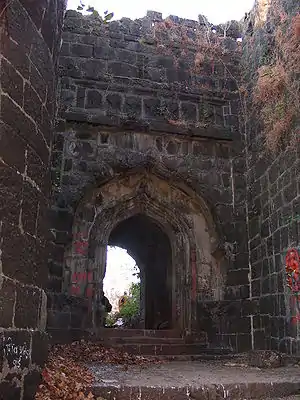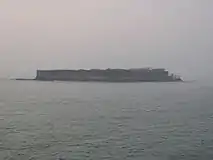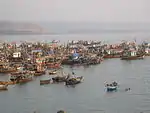Suvarnadurg
Suvarnadurg ( Marathi : सुवर्णदुर्ग translation: Golden Fort, also spelt Severndroog in English, a spelling sometimes also used for Savandurga[2][3]) is a fort that is located between Mumbai and Goa on a small island in the Arabian Sea, near Harnai in Konkan, along the West Coast of India, in the Indian state of Maharashtra. The fort also includes another small land fort called the Kanakadurga at the base of headland of Harnai port on the coast. Building of the fort is credited to Shivaji, founder of the Maratha Empire, in 1660. Subsequently, Shivaji, other Peshwas and the Angres further fortified the forts for defence purposes.[4][5]
| Suvarnadurg Fort सुवर्णदुर्ग | |
|---|---|
| Part of Harnai port of Ratnagiri District | |
| Harnai, India | |
 Entrance to Suvarnadurg fort | |
 Suvarnadurg Fort सुवर्णदुर्ग | |
| Coordinates | 17.817°N 73.085°E |
| Type | Fort |
| Site information | |
| Controlled by | Government of Maharashtra |
| Open to the public | Yes |
| Condition | Ruins |
| Site history | |
| Built | Seventeenth century |
| Built by | Adil Shahi dynasty and later by Chatrapati Shivaji Maharaj [1] |
| Battles/wars | Marathas, Angrias and British |
| Events | Battles for the fort in 1755 and 1818 |
The literal meaning of Suvanadurga in Marathi language is "Golden Fort" as it was considered as the pride or the "feather in the golden cap of Marathas". Built by Adilshah Navy for defence purposes, the fort also had a shipbuilding facility. The basic objective of establishing the fort was to counter enemy attacks, mainly by the colonialists of Europe and also by the local chieftains.[5]
In the past, the land fort and the sea fort were connected by a tunnel, but this is now defunct. The present approach to the sea fort is only by boats from the Harnai port on the headland. It is a protected monument.[6]
Geography
The fort is on an island in the Arabian sea on the west coast within the jurisdiction of Ratnagiri district, off the Kanakadurga fort and below the headland Harnai port. The nearest town is Dapoli, a hill station (near Chiplun), 17 kilometres (11 mi) from Harnai. Kanakadurga,[7] the harbour fort, built originally as a strategic link to the sea fort has a lighthouse. Harnai, near the dilapidated Kanakadurg fort, is an important harbour, which is right on the edge of the land that protrudes into the Arabian Sea. This is a natural harbour known for large fishing and marketing. It is conjectured that the Kanakadurga fort [8] and other land side forts such as Bankot fort, Fategad fort and Gova fort[9] were built primarily as lookout forts for the security of the Suvarnadurg fort. There is no landing jetty at the Suvarnadurga fort. However, the landing is on the shores of the sandy beach of the rocky island. Another feature of the area is that a narrow channel separates the Gova, Kanakadurg[10] and Fattehgarh forts on the mainland.
- Climate
The general climate on the west coast, which is where the Suvarnadurg is located, could be categorised as hot and humid. The temperatures vary from a maximum of 38 °C (100 °F) in summer to a low of 24 °C (75 °F) in winter. South West Monsoon controls the precipitation on the west coast, which lasts from June to September, and rainfall is in the range of 140–170 centimetres (55–67 in).[11]
History
The fort was captured by Shivaji in 1660 by defeating Ali Adil Shah II (1656–1672). Kanhoji Angre (1667–1729), popularly known as "Samudratla Shivaji" (Shivaji of the sea) was the Koli[12] Admiral of the Maratha Navy; in 1696, Kanhoji's naval fleet was stationed here. However, the fort was formally handed over to Kanhoji in 1713 by Shahu Raja.[4][5]
Kanhoji Angre who was also known as Angria was appointed in 1698 as Admiral of the Maratha Naval Fleet by the Peshwas. He had complete control over the west coast, from Bombay to Vengurla, except for the fort of Janjira, which remained with the Siddis (for 200 years). Angre was considered to be a mercenary who attacked defenseless towns and also traders. He even attacked the East Indian Company's ship in 1702 and refused to release the six British captives. He severed his relations with the Peshwas in 1704 and was called "the Rebel Independent of the Raja Shivaji". In spite of the warning by the British that he should not attack or capture British ships, he captured their ships in 1707. He had a free run of the west coast from Surat to Dabol and captured all private vessels. When Shivaji's grandson was imprisoned, Kanhoji got his opportunity to stake his claim for independence. In 1713, he had captured Peshwa's general Bhairu, which forced the Peshwa general Balaji Rao (Commander-in-Chief of the Maratha forces) to come to an agreement with him. For maintaining "fealty" with the Sataras (Shivaji's family stronghold), he was granted 26 forts and its dependent villages, which included Suvarnadurg. In subsequent years, these forts became strongholds for piracy. According to both Indian historians of Anglo-Maratha Wars such as Anil Athale[13] and now revisionist western historians such as John Keay[14] and Simon Leyton. The pejorative pirate was used in British records, but the correspondence between the English and Maratha Navy suggests more a communication between the Maratha state and a trading company without permits, the English East India Company. With the English being the transgressors (a.k.a. pirates). Simon Leyton writes: "It is now generally accepted by historians that Kanhoji [Angria], at least, was not a pirate in any sense of the word; rather, he is more properly thought of as the 'Admiral' of the Marathas"—an Indian Kingdom—"who for many years confronted European attempts to claim navigational rights over coastal shipping lanes".[15] With his new ordered control, Kanhoji held complete control over a coast line stretching over a coast length of 240 miles (390 km) and 40 miles (64 km) width extending from Bombay (now Mumbai) to Vengurla to the south. He later entered into an agreement with the British, which went against him as the British flouted all terms with him. Humiliated by this treatment by the British he decided to attack them. He entered into an alliance with the Raja of Satara, equipped his vessels and manned them by the best crew consisting of Dutchmen. He also employed a Jamaican pirate as his chief gunner. Many European pirate forces had also joined his army after the Treaty of Utrecht of 1713–14 (comprising a series of individual peace treaties among several European states including England, France and Spain, among others). With this force, he terrorized the East India Company.[5][16]
Kanhoji relentlessly carried on his fight against the British and in 1721 joined hands with the Portuguese; when 33 British soldiers were killed, 21 wounded and many ammunition and field guns were seized by the Marathas. In 1722, when Kanhoji was to attack the English factory at Karwar, in spite of the British sending their ships 'Victoria' and the 'Revenge' to attack Kanhoji's forces, he was not cowed down; even though his Dutch Commander was killed and his 16 ships were captured. However, he died on 4 June 1729, an unvanquished hero for 31 years against all foreign attacks.
He had two legitimate and two illegitimate sons, and Sambaji his legitimate son was given control of Suvarnadurg. Following the death of one of the brothers in 1734, there were intense fights and acts of piracy continued. In spite of attacks by the British in 1732, Sambaji was back in Suvarnadurg unharmed. However, by 1749, Tulaji, the stepbrother of Sambaji, had become very powerful and his ships sailed unharmed, even much bolder than what his father Kanhoji had achieved. This situation forced the Peshwas to join hands with the British to suppress Tulaji. In 1755, they jointly attacked Tulaji's stronghold of Suvarnadurg and took control of the fort within 48 hours. Suvarnadurg was then given to the Peshwas that was considered a humiliating surrender by the Peshwas to the British.[5][17]
Subsequent to Kanhoji's demise, Tulaji Angre took charge of Suvarnadurg and it became the seat of his power. However, he fell foul of the Peshwas. He was considered arrogant. In the war with Tulaji, Peshwas were supported by the British. The joint siege of the fort lasted from 25 March to 2 April 1755. On 12 April 1755, Commodore James captured the fort and formally handed it over to the Peshwas. However, this support proved detrimental to the Peshwas, as the British extracted, as a reward, control over the Bankot fort but only allowed the Peshwas to have control over the Suvarnadurg. In 1802, Bajirav Peshwa under attack by the Holkars was trying to take refuge in this fort but had to flee to Vasai as he was chased to the fort by the Holkars. In 1818, Captain William of the British army attacked the fort and took full control of it on 4 December 1818. Soon thereafter the other forts also came under British control. The fort was thus under the control of the Peshwas till 1818. The fort has witnessed a scene of "triumph and tragedy, of the display of heroic courage and abject cowardice." [4][5][18]
The Angrias are also credited with not only strengthening the fort but also establishing the shipbuilding yard at Suvanadurg and creating a large fleet of warships to secure the west coast, the Konkan coast, from attack from the British, French, Dutch and Portuguese colonialists. It is also inferred that the small forts (Guva, Kanakadurga, Bankot fort, Fattegad fort and Gova fort) were primarily built by Kanhoji Angre to defend Suvarnadurg from any enemy attack from the land route.[4]
Structures


Suvarnadurg fort is located on a rocky island in the Arabian Sea on the west coast. It is spread over an area of 8 acres (3.2 ha) and is about 1 mile (1.6 km) from the main land.[5] As is common in other similar forts, it is encircled by a dry moat. It tapers towards the southern direction from where the Kanakadurga fort is clearly visible. The walls have been mostly cut out of the rock exposures on the island. However, some part of the fort walls are built with large stone blocks of 10–12 feet (3.0–3.7 m) square. It has two entrances or gates, known as the 'Mahadarwaja' (big gate) also called the postern wall (above the high tide level) on the east and 'Chor Darwaja' on the west; the former gate faces the land and the latter faces the sea. The fort comes into sight only at very close quarters. The fort can be approached only during the low tide condition when it is also easier to walk in the precincts of the fort. The present entry from the main east gate is blocked by thorny bushes but can be accessed from a narrow entry, locally known as the devdis. At the main entry, carvings of a Hanuman carved on the wall and a carved turtle on one of the leading steps are seen. The sea-gate depicts carved figures of a tiger, eagle and elephants. The fort is fortified with many bastions, which also have small built-in rooms. The central part of the fort has two granaries and a decrepit building. From the Chor Darwaja, steps lead to the fort. Locations of old palaces in the fort area are inferred from the large number of foundation plinths seen in the fort area. A stone building in the fort precincts has been identified as an ammunition magazine. Fifteen old guns have also been located in the fort.[4][5][19]
There are several potable water sources (tanks, ponds and wells) in the fort; however, these dry up in the summer months. There is step well, which has plenty of water.[4][5]
- Kanakadurga fort
Kanakdurga fort (headland fort) projects into the sea, adjoins the Harnai port and is spread over an area of 0.25 hectares (0.62 acres). It is approached through a flight of steps. This fort is now in ruins, except for a few water tanks, two dilapidated bastions (one at each end), a lighthouse on elevated ground, and also a residence for the caretaker. It was also once a military camp. The fort has nine water ponds with abundant water supply, of which eight are separated by stone walls and the ninth pond is a little away to the west.[4][5]
Visitor information
Mumbai is at a distance of 230 kilometres (140 mi) from Harnai. Harnai, located in a rocky bay, has an all-weather road that connects to Dapoli and Khed. The road distances to other nearby forts and towns are: Bankot-Anjarle-Harnai: 23 kilometres (14 mi); Dapoli-Harnai: 16 kilometres (9.9 mi); and Anjarle-Harnai: 7 kilometres (4.3 mi). The only approach to the fort is by boats, from Harnai. Boats have to be arranged through the local fishermen. It is a port of call for coastal steamers and thrives on fishing as a major marketing centre.[5] The nearest railway station on the Konkan Railway of the Indian Railways is at Khed. The nearest airport is at Mumbai.
References
- Sen, Sailendra (2013). A Textbook of Medieval Indian History. Primus Books. p. 207. ISBN 978-9-38060-734-4.
- Walter Hamilton (M.R.A.S.) (1820). A geographical, statistical, and historical description of Hindostan, and the adjacent counties, Volume 2. J. Murray. p. 378.
- admin. "History of Suvarnadurg, Harnai | Taluka Dapoli". Retrieved 10 January 2019.
- "Suvarnadurg Fort". Government of Maharashtra. Retrieved 13 January 2010.
- "Harnai". Maharashtra Gazetter Department. Archived from the original on 14 January 2008. Retrieved 14 January 2010.
- "List of the protected monuments of Mumbai Circle district-wise" (PDF).
- admin. "Kanakdurg, Harnai | Taluka Dapoli". Retrieved 10 January 2019.
- "Kanakdurg". Taluka Dapoli.
- admin. "Goa fort, Harnai | Taluka Dapoli". Retrieved 10 January 2019.
- "Kanakdurg". www.talukadapoli.com.
- Naravane p.16
- LT GEN K. J., SINGH. "As NDA cadet, I was witness to Vice Admiral Awati's kindness". ThePrint.In. Retrieved 7 November 2018.
- Athale, Anil (2002). Struggle for Empire: Anglo-Maratha Wars, 1679–1818. Reliance Publishing House. ISBN 9788175101203.
- Keay, John (8 July 2010). The Honorable Company: A History of the English East India Company. Harper Collins, U.K. ISBN 9780007395545.
- Leyton S (2013). "The "Moghul's Admiral": Angrian "Piracy" and the Rise of British Bombay". Journal of Early Modern History. 17: 75–93. doi:10.1163/15700658-12342358.
- Saletore, Rajaram Narayan (1978). Indian Pirates: From the Earliest Times to the Present Day. Concept Publishing Company. pp. 99–102. Retrieved 13 January 2010.
- Saletore pp.109, 111
- Naravane p.4
- Naravane, M. S (1998). The maritime and coastal forts of India. Islands. APH Publishing. p. 12. ISBN 978-81-7024-910-8. Retrieved 14 January 2010.
External links
| Wikimedia Commons has media related to Suvarnadurg. |